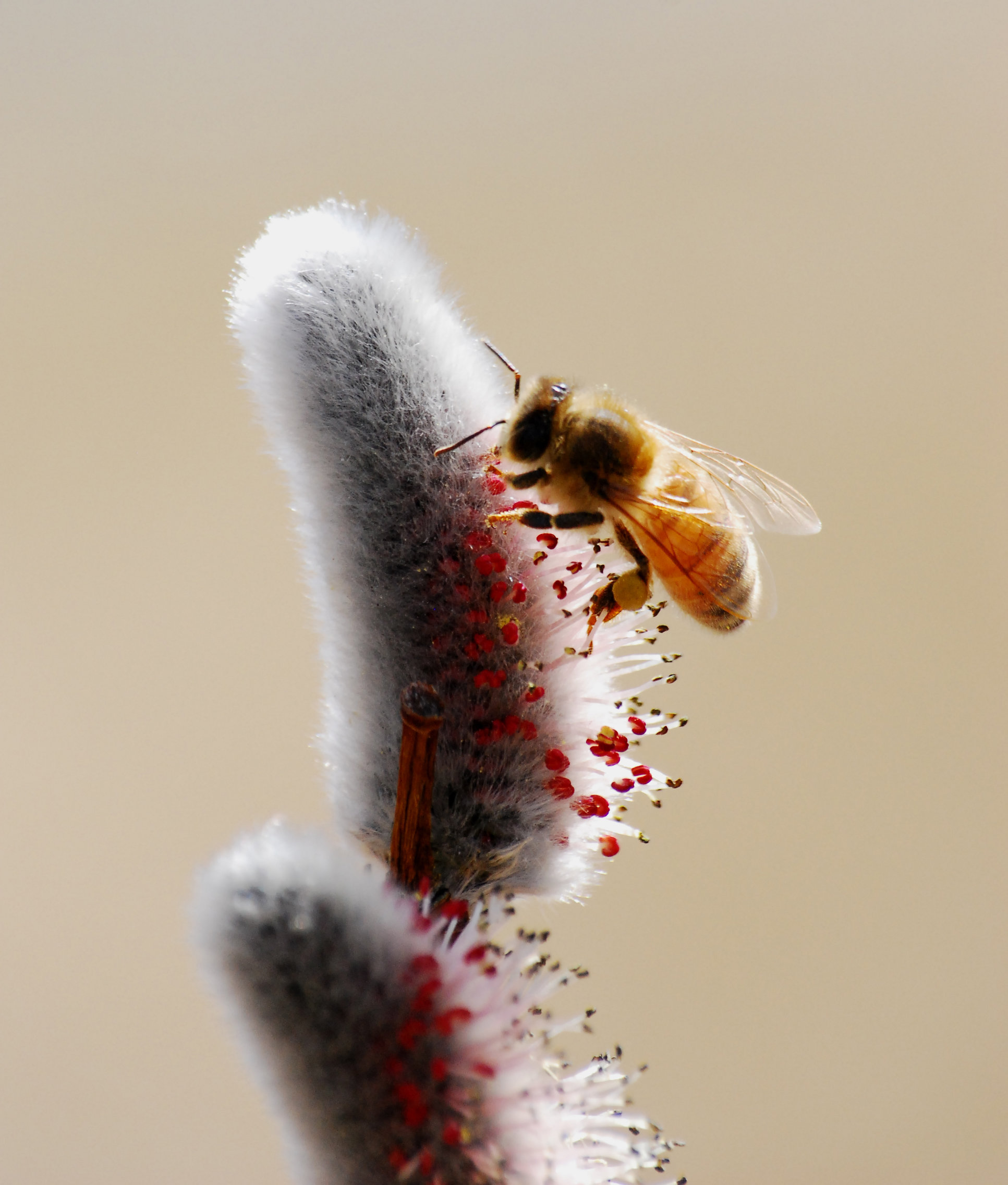Honeybees and human beings are in a long-term relationship. Humans have been seeking the honeybees’ product since as far back as 2400 BCE, when the first beekeepers were building hives in Egypt. Besides being captivated by the honey that bees produce for themselves as food, people all over the world are fascinated by the social structure of the beehive. From an evolutionary standpoint, it is hard to believe that the selfless nature of each individual bee could successfully yield proliferating genes. Yet honeybees originated in Africa and now can be found on every continent except Antarctica.[13] Something they are doing must be working. Honeybees living together in a hive make up a colony, and a colony is wholly dependent upon each bee inside for survival. Humans also have a heavy dependence upon the honeybee. 130 fruit and vegetable crops depend on insects for pollination. Alfalfa, almonds, apples, onions, broccoli, carrots, and sunflowers, to name a few, rely 100 percent on insect pollinators to reproduce. Honeybees compose a large percentage of the insect population doing that pollinating. It is estimated that honeybees contribute $207 billion economically worldwide, and $15 billion specifically to the US. One out of every three bites of food you take is a direct result of bee pollination.[2] The fate of the bees is of more than just scientific interest. It is critical to our present way of life.
Recently there has been a decline in honeybee populations worldwide, seen most dramatically in the Northern Hemisphere. In the US, the number of commercially managed hives has gone from 4.5 million in the 1940s to 2.5 million today, while the amount of crops requiring pollination has gone up by 300 percent.[12]
In 2006, beekeepers began noticing a phenomenon now known as Colony Collapse Disorder (CCD) in which apiaries were losing up to 100 percent of their bees, when the normal mortality rate was 20 percent.[2] CCD was unique in that the female worker bees that went out to collect pollen and nectar would disappear, their bodies never to be found, leaving hives with queens, food stores, and baby bees known as brood to die. The cause of hives abruptly collapsing is still unknown, although a myriad of possible contributing factors have been discussed. Neonicotinoids, a fairly new group of pesticides, have been implicated in proving deadly to honeybees. Neonicotinoids are systemic pesticides, meaning they are administered to the soil, seed, or as trunk injections and are then absorbed by the plant itself, making it toxic to insects that eat it. The issue for honeybees specifically arises because the neonicotinoids get into the pollen and nectar of the flowers. Other insecticides being sprayed before the plants were in bloom somewhat protected the bees from the chemicals’ detrimental effects. Due to the nature of neonicotinoids, the plant metabolizes the chemicals, and regardless of when they are applied, they can end up in the plants, pollen, and nectar. The neonicotinoids can also persist in the soil for months or years after the initial application, and can even be absorbed by untreated plants. The greatest risk to pollinating insects comes from neonicotinoids that are approved for home and garden use, because they can be applied at higher doses than those used for agricultural purposes.[8]
The link between CCD and neonicotinoids is controversial. Alex Lu from the Harvard School of Public Health conducted a study investigating a particular neonicotonoid known as imidacloprid. The study looked at the use of genetically modified corn that had its seed coated with imidacloprid. High fructose corn syrup (HFCS), a byproduct of corn, is often fed to hives being used to pollinate agricultural lands to boost bee productivity. It is widely practiced as a cheap strategy to increase bee yield. The HFCS from corn coated in imidacloprid, according to Lu, can contain high levels of the neonicotinoid. According to the results of his study, neonicotinoids were the most likely culprit in CCD.[5] This led to an uproar, primarily from Bayer, the company that manufactures imidacloprid. Bayer argued their company scientists found no link between CCD and imidacloprid.[3] Lu’s study was called into question by many other scientists outside of Bayer’s payroll as well. As of now, there is no general consensus on what is fact and what is fabrication.
The call to ban neonicotinoids has fostered the development of very polarized positions on the issue, which is not helping the bees. The role of a researcher is a difficult one, as they are often the first ones on the scientific scene who are able to provide insight into what is actually going on. At the same time, when scientists take on the role of activists, it can draw scrutiny and doubt to their data, which is where their power lies. Another example of this can be seen in the case between University of California researcher Tyrone Hayes and Syngenta, the manufacturer of the second most popular herbicide in the US, Atrazine. In his studies, Hayes concluded that Atrazine runoff led to sexual deformities in frogs. He has spent the past 15 years battling Syngenta, giving hundreds of lectures to try and spread the research about the dangers of Atrazine, while Syngenta has used their corporate strength to discredit and defame him.[1] Both Hayes and Lu have garnered support and rebuke from the scientific community as a result of these scandals. Because of the conflicting interests surrounding information on neonicotinoids, facts regarding the chemical impact on bees have become muddled, making it difficult for policy changes to be made.
The battle over neonicotinoids has emerged at the forefront of mainstream understanding of problems afflicting bees. People hear “Colony Collapse Disorder” and think that is the center of bees’ issues, but it is not. The number of honeybees was declining long before 2006. Fungicides have been linked to increased rates of disease in honeybee colonies, and loss of habitat is also a huge issue.[10] The US agricultural system relies heavily on monoculture practices in which one crop is grown at a time, and often in the same place over and over again. This means that there are only flowers in bloom for a limited time each year in these areas, for hundreds of square miles. Honeybee colonies are unable to survive in these environments because they need flowers all year round to collect pollen and nectar. The pollen is a source of protein for the hive, and the nectar gets converted to honey, and is the hive’s carbohydrate source.
Commercial beekeepers have adapted to today’s agribusiness by transporting their beehives from farm to farm, being paid by large-scale farmers to pollinate their crops. If they are not pollinated, the plants will not produce fruit. When the bloom period ends, the bees are loaded onto a truck and driven to the next location to repeat the pollination process again. The stress that the journeys alone impart onto the bees is exacerbated by the fact that, due to the natural tendency for humans to work during the day, these hives are moved in the daylight hours. The older and stronger female worker bees, the ones that leave the colony to collect pollen and nectar, are used to naturally being busy all day long. When the hive is moved during the day, the strongest members of the hive can be left behind. This results in less robust hives, which are then less able to fight off parasites, another growing threat to honeybees. The Varroa mite is a parasite that is wreaking havoc on the bees. The mites feed on the bees’ circulatory fluid, and compromise their immune system, making them more vulnerable to viruses.[9] Another parasite known Nosema has been on the rise in colonies as well. The Best Bees, an urban beekeeping business in Boston, found Nosema in almost all of the hives they managed last year.
The loss of honeybees has been generating a lot of buzz lately. Europe has been experiencing a decrease in its honeybee population since 1965, but the pattern is diverse, and not as consistent as the significant and continuous decline in North America.[14] However, countries in Europe have taken more concrete steps to address bee issues. In 2008 the German Office for Consumer Protection and Food Safety suspended approval of imidacloprid and clothianidin, another neonicotinoid linked with unhealthy bees. Bayer, the powerful company that produces these chemicals, is headquartered in Germany, and their government agency was willing and able to stop the approval until more data can be presented to justify their safety.[4] The European Food Safety Authority has implemented a two-year restriction on neonicotonoids and will re-evaluate the safety of their use at the end of this time period. The US Environmental Protection Agency (EPA) granted what is called a “conditional approval” of clothianidin in 2003. This allowed for the pesticides to be approved without doing field studies to determine that clothianidin would have no “unreasonable adverse effects on the environment.” The approval was granted under the condition that the company making clothianidin would perform the studies and eventually submit those studies. That has yet to happen. Now the EPA is in the midst of a lawsuit against a coalition of beekeepers and environmental and consumer advocacy groups for failure to protect pollinators from dangerous pesticides. They are seeking the suspension of neonicotinoids until they are proven safe for the environment and pollinators. [11]
Honeybees matter to our environment’s health. They are vital to our food system. Their numbers are declining all over the world, particularly here in North America. There are many factors contributing to this, without one in particular acting alone. Human-imposed habitat loss, the reliance on monoculture agricultural systems in agribusiness, pesticides, fungicides, and viruses are all contributing to this phenomenon. Beyond these causal issues, the EPA is not taking basic steps needed to help the bees, even though it is the very agency that should be advocating on their behalf. Restrictions on the use of neonicotinoids and regulatory requirements for more research data on the power of insecticides are imperative. Everyone, from urban city dwellers to industrial agricultural farmers, can at least begin by planting more flowers in their respective environments to help the bees.
Lena King
Biology 2015
References:
[1] Aviv, Rachel. “A Valuable Reputation” New Yorker, February 10th 2014, accessed February 12th 2014 http://www.newyorker.com/reporting/2014/02/10/140210fa_fact_aviv?currentPage=all
[2] Barrionuevo, Alexei. “Honeybees Vanish, Leaving Keepers in Peril”, New York Times, February 27th 2007, accessed February 17, 2014, http://www.nytimes.com/2007/02/27/business/27bees.html?pagewanted=all&_r=0
[3] Bayer says “Bee Study” is seriously flawed. Croplife, April 6th 2012, accessed February 23, 2014. http://www.croplife.com/crop-inputs/insecticides/bayer-says-bee-study-is-seriously-flawed/
[4] Bee’s, Bayer, and Blame- Is Big Business Killing the Largest Labor Force on the Planer? The Lohasian, June 6th 2008 Accessed February 20th http://www.thelohasian.com/2008/06/bees-bayer-and-blame-is-big-business.html
[5] Chengsheng Lu. Warchol, Kenneth. Callahan, Richard. “In situ replication of honey bee colony collapse disorder” The Bulletin of Insectology 65 (2012): 1-8.
[6] Hakim, Danny. “European Agency Warns of Risk to Humans in Pesticides Tied to Bee Deaths” The New York Times, December 17th 2013, accessed February 17, 2014 http://www.nytimes.com/2013/12/18/business/international/europe-warns-of-human-risk-from-insecticides.html?_r=0
[7] Helman, Scott. “The bee keepers” The Boston Globe, June 23rd 2013, accessed February 17, 2014 http://www.bostonglobe.com/magazine/2013/06/22/the-harvard-scientist-linking-pesticides-honeybee-colony-collapse-disorder/nXvIA5I6IcxFRxEOc8tpFI/story.html
[8] Holland, Jennifer “The Plight of the Honeybee” National Geographic May 10th, 2013. Accessed February 20th http://news.nationalgeographic.com/news/2013/13/130510-honeybee-bee-science-european-union-pesticides-colony-collapse-epa-science/
[9] Hopwood, Jennifer. Vaughan, Mace. Shepherd, Matthew. Biddinger, David. Mader, Eric. Black, Scott Hoffman. Mazzacano, Celeste. Are Neonicotonoids Killing Bees? Xerces Society for Invertebrate Conservation, 2012.
[10] Pettis, Jeffrey. Lichtenberg, Elenor. Andree, Michael. Stitzinger, Jennie. Rose, Robyn. vanEngilsdorp, Dennis. “Crop pollination exposes honeybees to pesticides which alters their susceptibility to gut pathogen Nosema ceranae. “ The Public Library of Science (2013) Accessed February 20th 2014. DOI 10.1371/journal.pone.0070182.
[11] Pollinators and Pesticides. Center for Food Safety. Accessed February 12th 2014
http://www.centerforfoodsafety.org/issues/304/pollinators-and-pesticides
[12] Spivak, Marla. “Why Bee’s are Dissapearing”, TED-Ideas worth Spreading, June 2013, accessed February 19th, 2014. http://www.ted.com/talks/marla_spivak_why_bees_are_disappearing.html
[13] Wilson-Rich, Noah. The Bee: A Natural History. Princeton: Princeton University Press, 2014.
[14] UNEP. Global Honey Bee Colony Disorders and Other Threats to Insect Pollinators. United Nations Environment Program Emerging Issues 2010. Accessed February 20th, 2014. http://www.unep.org/dewa/Portals/67/pdf/Global_Bee_Colony_Disorder_and_Threats_insect_pollinators.pdf



